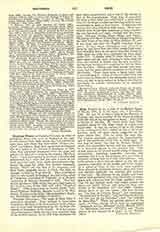

Crutched Friars (or CROSSED FRIARS), an order of mendicant friars who went to England in the thirteenth century from Italy, where they had existed for some time, and where they were called “Fratres Cruci f eri” (see below). Their first appearance in England was at a synod of the Diocese of Rochester in 1244, when they presented documents from the pope and asked to be allowed to settle in the country (Matthew Paris). Each friar carried in his hand a wooden staff surmounted by a cross and had also a cross of red cloth upon his habit, from which circumstances originated the name by which they became commonly known. Their rule was that of St. Augustine and their habit, originally brown or black, was later on changed to blue by Pope Pius II. They established eight or nine houses in England, the first being either at Colchester (according to Dugdale), or at Reigate (according to Reyner), founded in 1245. They settled in London in 1249, where they gave their name to the locality, near Tower Hill, still called “Crutched Friars”. Other houses were at Oxford (1348), York, Great Weltham (Suffolk), Barham (a cell to Gt. Weltham), Wotton-under-Edge (Gloucestershire), Brackley (Northants), and Kildale (Yorkshire).
FRATRES CRUCIFERI.—The origin of these friars is somewhat uncertain. They claimed to have been founded in the East, in the first century, by St. Cletus, and to have been reconstituted by St. Cyriacus, Patriarch of Jerusalem, in the fourth. It is not known when they came to Italy, but they were certainly there in the twelfth century, for in 1169 Pope Alexander III gave them constitutions and a rule of life similar to that of the Augustinians. Pope Pius II prescribed for them a blue habit and substituted a small silver cross for the larger wooden one they had hitherto been accustomed to carry in their hands. It was from this custom that they obtained their name. Their monasteries were at one time numerous in Italy, numbering two hundred and eight, divided into five provinces: Bologna, Venice, Rome, Milan, and Naples. The priory of S. Maria di Morella at Bologna was made the chief house of the order by Pope Clement IV, and it was from this that the English Crutched. Friars came. In later times corruptions were allowed to creep in, and from that and other causes their numbers dwindled down to not more than fifty houses in 1656, when the order was suppressed by Pope Alexander VII. A similar order of friars, known by the same name and like them claiming to come from the East, also existed in France and the Low Countries, having been introduced or organized in 1211 by Theodore de Celles. Helyot says their houses were numerous, but the order suffered extinction in the French Revolution. These friars wore a black habit with a red cross upon it. Other Fratres Cruci feri were also to be found in Bohemia in the thirteenth century and some are said to have existed in Ireland, but there is practically no reliable information to be obtained about them.
G. CYPRIAN ALSTON

